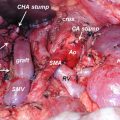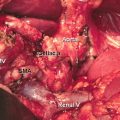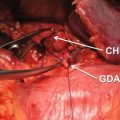Type of procedure
Shin et al. [18]
Magge et al. [17]
Kooby et al. [16]
Inclusion period
2006–2013
2002–2010
2000–2008
Patients, n
LDP
70
28
23
ODP
80
34
189
Operative time, min
LDP
239
317
238
ODP
254
294
230
EBL, ml
LDP
–
290a
422a
ODP
–
570a
790a
Tumor size, mm
LDP
30a
37
35
ODP
35a
45
45
R0 resection rate, %
LDP
76
86
74
ODP
84
88
73
Resected LN, n
LDP
12
11
14
ODP
10
12
13
Adjuvant CTx, %
LDP
79
89
57
ODP
68
85
70
Median survival, months
LDP
33
19
16
ODP
29
19
16
Radical antegrade modular pancreatosplenectomy (RAMPS) for left-sided pancreatic cancer was first described in 2003 [20]. RAMPS aims to facilitate radical tumor resection combined with extensive lymph node dissection along the celiac axis, the hepatic artery, and the retroperitoneal region, including the anterior renal fascia (anterior RAMPS) and, optionally, the left adrenal gland (posterior RAMPS). Laparoscopic RAMPS is also feasible, but long-term oncological outcomes are yet to be determined, and the true oncological and survival benefits of this procedure have not yet achieved generalized consensus [21].
Involvement of other organs, such as the adrenal glands, kidney, colon, or stomach, is relative but not absolute contraindication for the laparoscopic approach, as concomitant organ resection is possible during laparoscopic RAMPS. However, evidence of multivisceral resection by laparoscopic approach in left-sided pancreatic cancer is low.
The potential benefits of LDP include the prompt instigation of adjuvant therapy, compared with ODP, which may have a role in determining long-term outcome and improving overall survival.
29.2.3 Conclusion
LDP seems to be a technically safe and feasible approach, providing favorable perioperative outcomes in terms of reduced estimated blood loss and shorter LOHS compared with ODP. LDP demonstrates short- and long-term oncological outcomes similar to those after ODP in patients with pancreatic cancer. Although no randomized trial has been performed to date, many centers consider LDP as the “gold standard” approach for left-sided pancreatic tumors in selected patients except for locally advanced cancer.
29.3 Robot Distal Pancreatectomy (RDP) for Pancreatic Cancer
Conventional laparoscopic surgery exhibits its own limitations, including reduced freedom of movement within the abdominal cavity, reduced precision, and poor ergonomics. These limitations translate into a long learning curve, which requires longer time and more effort to develop and maintain such advanced laparoscopic skills. Therefore, since the first LDP was reported by Cuschieri in 1996, it remains not widely adopted. By contrast, robotic system allows complex dissections, and this method is performed more easily and precisely. In 2003, Giulianotti et al. [22] completed the first robot-assisted pancreatic resection. Since then, more investigations have been made on the applications of various surgical resection procedures for pancreas using robotic surgical systems.
Robotic surgical systems exhibit several advantages over conventional laparoscopic instrumentations. Robotic surgical systems provide reduced operator fatigue, motion stabilization by improved dexterity of wristed instruments, and magnified three-dimensional (3D) imaging, and they have been demonstrated to be superior to laparoscopic surgery when performing complex surgical maneuvers. These advantages facilitate hemostasis, as well as control of the spleen artery, venous mesenteric and portal regions, and small vascular plexus surrounding the pancreas.
29.3.1 Perioperative and Oncological Outcomes of RDP for Pancreatic Cancer
29.3.1.1 Perioperative Outcomes
Centers performing both laparoscopic and robot-assisted pancreatic surgery remain scarce; thus, limited comparative evidence exists. Only a handful of studies to date have attempted to compare the outcomes of RDP versus LDP [23–26]. Most of these studies demonstrated comparable outcomes between RDP and LDP, such as postoperative morbidity including POPF rates and LOHS. However, in general, RDP appeared to be associated with a longer operation time and increased rate of spleen preservation compared with LDP. In several studies, operative time was longer in RDP than in LDP. It can be explained by the longer docking time of the robotic system than the laparoscopic system and the burden of learning curve. Docking and undocking of the robot can be time-consuming especially for surgical teams during their learning phase. However, some large series reported shorter operation times with RDP compared with LDP after the learning curve [24]. The spleen should be preserved as much as possible in the case of benign or borderline diseases because spleen-preserving distal pancreatectomy offers patients other clinical benefits as well, such as lower morbidity, shorter hospitalization time, and prevention of life-threatening sepsis by splenectomy [27]. Others have demonstrated higher rates of POPF with splenectomy during distal pancreatectomy [28]. However, concomitant en bloc splenectomy is performed with distal pancreatectomy mainly for technical reasons, such as to make resection easier, shorten operative time, and minimize bleeding from dissecting splenic vessels. Spleen-preserving LDP is relatively time and labor consuming. RDP was associated with a significantly higher spleen-preserving rate, which resulted from the fact that the robotic approach was more effective at controlling splenic vessel bleeding due to the good flexibility of instruments and high-definition view in this system [29]. The cost-effectiveness of RDP is inconclusive, and the added benefit of the robot-assisted technique remains controversial to date.
29.3.1.2 Oncological Outcomes
Compared with LDP for pancreatic cancer, RDP appears capable of finer lymph node dissection and more radical dissection. Concerning pancreatic cancer, Daouadi et al. [24] retrospectively compared 94 LDP with 30 well-matched RDP patients. The oncological outcomes were superior for RDP, with higher rates of margin-negative resection and improved lymph node clearance. Nevertheless, randomized clinical trials demonstrating that these potential advantages correspond to an actual superiority of RDP over LDP are still lacking.
29.3.2 Conclusion
Robot-assisted platforms aim to improve technical ability during a surgical procedure by providing highly defined 3D vision, eliminating tremor, and improving surgeon ergonomics. RDP can be safely adopted for left-sided pancreatic cancer by appropriate patient selection. RDP was similar to LDP in terms of most operative outcomes such as postoperative morbidity, POPF, blood loss, rate of blood transfusion, and LOHS. It was also associated with high rate of spleen preservation but longer operation time. RDP is associated with similar short-term oncological outcomes, such as margin-positive rate and numbers of lymph nodes harvested, compared with LDP. However, long-term results in terms of oncological adequacy of RDP for pancreatic cancer are not yet available. The main limitation associated with RDP is its greater costs. Other limitations of RDP include the potential need for more ports and the lack of tactile feedback. They are important barriers to widespread implementation of RDP. However, robotic technology has some nonmeasurable benefits: It is ergonomically more comfortable; it gives a feeling of stability and security; the surgeon feels that each surgical step of the procedure is safer and faster. The actual benefits of RDP over LDP are still under investigation.
29.4 Minimally Invasive Pancreaticoduodenectomy (MIPD) for Pancreatic Cancer
PD is considered one of the most challenging and complex operations in abdominal surgery. It is a highly demanding surgical operation because it needs very delicate manipulation during resection and very laborious reconstruction, which are the reasons for the extremely low diffusion and some degree of skepticism over the minimally invasive approach in the era of pancreatic head resection.
29.4.1 Indication and Incidence of MIPD for Pancreatic Cancer
The indications are the same as for the open pancreaticoduodenectomy (OPD) for surgeons experienced in MIPD, whereas surgeons with limited experience should exclude obese patients and limit the procedure to small pancreatic cancer confined to the pancreatic head without suspicion of vascular involvement.
According to the NCDB, of the 4421 patients who underwent PD in 2010 and 2011, 4037 (91%) patients underwent OPD and 384 (9%) underwent laparoscopic pancreaticoduodenectomy (LPD); 75.7% of hospitals performed OPD only and 1% of all centers performed ≥10 LPDs [30]. The limited incidence of pancreatic tumors reduced the number of the centers with sufficient caseload. Published clinical series of experience with MIPD have been limited so far to reports from high-volume institutions.
29.4.2 Perioperative and Oncological Outcomes of MIPD for Pancreatic Cancer
29.4.2.1 Perioperative Outcomes
Although MIPD is still not universally practiced, it is now receiving more interest with increasing proficiency in the laparoscopic skills of surgeons and advances in technology, including surgical robotics. In recent years, a large number of single-institution series of MIPD have been performed, and a variety of studies have been reported. On these series comparing LPD and OPD, LPD seems advantageous over OPD in terms of estimated intraoperative blood loss, but it results in longer operative time. The rate of postoperative complications, POPF, including clinically relevant POPF, and delayed gastric emptying are comparable following OPD and LPD. However, the latter is associated with shorter LOHS (Table 29.2).
Table 29.2
Large single-center series comparing LPD and OPD
Type of procedure | Song et al. [31] | Croome et al. [32] | Asbun et al. [33] (2012) | ||
|---|---|---|---|---|---|
Inclusion period | 2007–2012 | 2007–2012 | 2005–2011 | ||
Patients, n | LPD | 93 | 11 | 108 | 53 |
OPD | 93 | 261 | 214 | 215 | |
Operative time, min | LPD | 483a | 379 | 541a | |
OPD | 348a | 388 | 401a
Stay updated, free articles. Join our Telegram channel
Full access? Get Clinical Tree
 Get Clinical Tree app for offline access
Get Clinical Tree app for offline access

| ||



